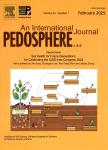Mechanisms of Salt Tolerance in Transgenic Arabidopsis thaliana Carrying a Peroxisomal Ascorbate Peroxidase Gene from Barley
Mechanisms of Salt Tolerance in Transgenic Arabidopsis thaliana Carrying a Peroxisomal Ascorbate Peroxidase Gene from Barley作者机构:State Key Laboratory of Soil and Sustainable Agriculture Institute of Soil Science Chinese Academy of Sciences Nanjing 210008 (China). Graduate School of the Chinese Academy of Sciences Beijing 100049 (China) Graduate School of Bioagricultural Sciences Nagoya University Nagoya 464-8601 (Japan
出 版 物:《Pedosphere》 (土壤圈(英文版))
年 卷 期:2008年第18卷第4期
页 面:486-495页
核心收录:
学科分类:09[农学] 0903[农学-农业资源与环境] 090301[农学-土壤学]
基 金:a grant of CAS (Chinese Academy of Sciences) Research Program on Soil Biosystems and Agro-Product Safety (No.CXTD-Z2005-4) the Knowledge Innovation Project of CAS (No.KZCX3-SW-439)
主 题:ascorbate peroxidase oxidative stress peroxisome soil salinity transgenic Arabidopsis thaliana
摘 要:Ascorbate peroxidases (APX), localized in the cytosol, peroxisome, mitochondria, and chloroplasts of plant cells, catalyze the reduction of H2O2 to water by using ascorbic acid as the specific electron donor. To determine the role of peroxisomal type ascorbate peroxidase (pAPX), an antioxidant enzyme, in protection against salt-induced oxidative stress, transgenic Arabidopsis thaliana plant carrying a pAPX gene (HvAPX1) from barley (Hordeum vulgate L.) was analyzed. The transgenic line pAPX3 was found to be more tolerant to salt stress than the wild type. Irrespective of salt stress, there were no significant differences in Na^+, K^+, Ca^2+, and Mg^2+ contents and the ratio of K^+ to Na^+ between pAPX3 and the wild type. Clearly, the salt tolerance in pAPX3 was not due to the maintenance and reestablishment of cellular ion homeostasis. However, the degree of H2O2 and lipid peroxidation (measured as the levels of malondialdehyde) accumulation under salt stress was higher in the wild type than in pAPX3. The mechanism of salt tolerance in transgenic pAPX3 can thus be explained by reduction of oxidative stress injury. Under all conditions tested, activities of superoxide, glutathione reductase, and catalase were not significantly different between pAPX3 and the wild type. In contrast, the activity of APX was significantly higher in the transgenic plant than in wild type under salt stress. These results suggested that in higher plants, HvAPX1 played an important role in salt tolerance and was a candidate gene for developing salttolerant crop plants.




